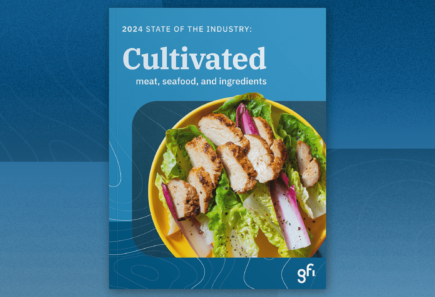Catalyzing alternative protein entrepreneurship
Do you want to ensure alternative protein research realizes its impact beyond the lab? Starting a company that addresses critical whitespaces and bridges the gap between basic, scientific research and commercial reality can help. This guide will take you through the steps to starting your high-impact alternative protein spinout and commercialize university research.
Introduction to entrepreneurship at universities
The importance of catalyzing alternative protein innovation
What do we mean by innovation and entrepreneurship?
Increasingly, innovation and entrepreneurship are becoming top priorities at academic institutions around the world—so it’s important to understand what these terms mean in a university context. Not to be confused with invention (the creation of something new), innovation refers to the successful application of new ideas. An innovative idea can’t just be novel—it also has to be useful.
Entrepreneurship is the creation of economic value, and this usually involves innovation. In the alternative protein field, entrepreneurs leverage new technologies to create better food products, processes, and services.
For some real-life examples of innovation and entrepreneurship from the APP, check out the innovation section of the APP impact page.
Misconceptions about entrepreneurship
If you’re new to entrepreneurship, you might think all entrepreneurs have formal business experience or are somehow “born to lead”. In reality, people who advance innovation and entrepreneurship at universities have a variety of backgrounds and personality traits. You don’t need to know everything as long as you have a well-rounded team!
Science and entrepreneurship are often framed as separate “tracks” with entirely different skill sets. Upon closer inspection, you can find plenty of overlapping skills like problem-solving, effective communication, fundraising, perseverance, and collaboration. If you’re a scientist or researcher, you might be more suited to entrepreneurship than you originally thought.
One last misconception is that research conducted in privately-funded companies is bound to stay locked away as intellectual property. GFI and others in the alternative protein space have emphasized the need for open-access research to ensure we’re moving the field forward efficiently and rapidly. We’re optimistic that the industry will respond to this call—already, we’ve seen original research papers published by companies like Aleph Farms, BioTech Foods, Mosa Meat, and Believer Meats. New Harvest is also funding research to explore what values can incentivize open innovation in cellular agriculture.
What role do universities play?
Historically, universities were designed to generate and disperse knowledge through research and teaching. While they can be exceptional at conducting high-impact research, this doesn’t always translate to innovation. Universities often lack the infrastructure required to scale and transfer the impacts of their research to society—this is where commercialization comes into play.
In the research commercialization process, universities transfer their research results to companies, which then develop those results into new products and services. When these products and services reach consumers, there’s potential to benefit society at large. Commercialization can also generate interest and investment in emerging fields of research. For example, the Cohen-Boyer method of gene splicing was developed at Stanford University and licensed to Genentech, Amgen, and other companies, thereby accelerating the growth of the biotech industry.
By catalyzing alternative protein innovation at your university, you can maximize the societal impact of your research and accelerate the future of food. In this guide, we’ll explore mechanisms for translating an idea into impact, such as licensing novel technology and starting a business.
The ideal innovation ecosystem
The Third Mission of universities
In recent years, more universities are embracing the “Third Mission” of contributing to society and the economy. Universities strive to fulfill this mission through research commercialization; by transferring novel technologies to industry, they can demonstrate societal and economic impact.
Since most academic institutions were built to serve their original missions (i.e., teaching and research), the rise of the Third Mission uncovered a massive lack of support structures for entrepreneurial activities. In response, most major research universities have developed technology transfer offices, policies and incentive structures, and robust entrepreneurial networks.
Characteristics of entrepreneurial universities
If you’re interested in catalyzing alternative protein innovation as a student or researcher, it’s a good idea to evaluate the entrepreneurial strength of your university. What are the key features of entrepreneurial universities? Since research commercialization takes place at the university-industry interface, you can examine these two categories.
- University support structures: Within the university, there’s an abundance of programs and resources for entrepreneurs. The technology transfer office (TTO) is well aware of research happening on campus and makes useful connections with surrounding industries. Faculty members with research commercialization experience are eager to guide aspiring innovators. Accelerators and seed funds exist to facilitate the creation of new companies. Students from any discipline can take courses in the business school or participate in innovation competitions.
- Surrounding innovation community: Outside the university, there’s a network of companies, investors, and other enablers of entrepreneurship. Local industries recognize the university as a source of innovation opportunities and are excited to collaborate. The alumni community is enthusiastic about sharing their experiences and connections with students and researchers.
If your university lacks some of these internal support structures, it can be more challenging to commercialize your research or launch a student startup. In this case, you might lean into regional economic development centers or other off-campus innovation enablers. For instance, Southwest I-Corps supports students across the Texas and Southwestern U.S. regions (and is part of a larger network of innovation hubs). If you decide it makes more sense to pursue your business idea outside your university, we recommend reading our startup manual.
Developing your strategy
When it comes to entrepreneurship, the most effective strategies are highly dependent on the existing innovation ecosystem at your institution. This section will help you identify the resources available at your university to pursue your entrepreneurial goals.
Mapping the innovation landscape
Get to know your campus resources
Catalyzing alternative protein innovation is a huge undertaking that requires many champions and collaborators. If you spend time upfront to explore the resources available to you, each step of the commercialization process will be less daunting.
To map the innovation landscape, get acquainted with these groups:
- Technology transfer office (TTO): Also known as the technology licensing office (TLO) or technology development office, their main responsibility is to facilitate the research commercialization process. They can exist as an integrated part of the university, like the Office of Technology Commercialization at UT Austin, or they might exist as a subsidiary company, like Oxford University Innovation. Staff may consist of tech transfer project managers, intellectual property (IP) specialists, network and event coordinators, legal specialists, and more.
- Incubators and accelerators: These programs provide support for startups in the form of pre-seed funding, physical workspace, educational workshops, mentorship, and more. Incubators support startups at all stages, while accelerators are most useful for startups with a minimum viable product. Some incubators and accelerators take equity, but regional economic development organizations and university-based programs typically do not. Examples include ZIP Launchpad at San Diego State University and GROW for food tech startups in Singapore.
- Regional economic development centers: These organizations aim to promote economic development within a specific region, and they can potentially support efforts to position your area as an innovation hub for the alternative protein field. Some have a broad scope, like the Dialogue & Development Commission of Delhi, while others lean into specific industries, like San Diego Regional EDC and life sciences.
- Science and technology parks: Also known as university research parks, these spaces promote economic development by enabling knowledge sharing and technology transfer between the university and surrounding companies. Some parks function as technology hubs for startups, like Research Park at the University of Illinois Urbana-Champaign.
- Local alternative protein companies: Building relationships with local companies will make it easier to find peer support, collaborators, and mentors. To find companies in your region, check out GFI’s alternative protein company database and filter by location. Keep an eye out for diversified companies (those operating in multiple business segments) that might be keen to move into the alternative protein space.
You should also look out for these opportunities:
- Programs offered by the business school: Look out for entrepreneurship courses, minors, and certificates, which are often available to students from any discipline. For example, the Certificate in Entrepreneurship and Technology at UC Berkeley prepares students to become industry leaders, and they also offer courses on alternative protein innovation. If you’re a researcher without a business background, this can be a great place to find collaborators with complementary skill sets.
- Hackathons and innovation challenges: In these competitions, students collaborate in groups to develop solutions for specific problems. Perks can include networking events, mentorship, prize money, and other opportunities for professional development. Students at any university can apply to participate in the Cultivate Tomorrow Hackathon, which offers a space to explore and gain experience in cellular agriculture.
- Pitch competitions: These contests are for entrepreneurs to present their business ideas to a panel in the hope of winning prizes like cash, investment capital, and networking opportunities. There are multiple formats, including fast-paced elevator pitches and longer presentations with Q&A. Some universities (like Rice) open their pitch competitions to any student with a startup concept. Alternative protein startup Proxy Foods won a grand prize of $30,000 from Georgetown University’s pitch competition.
- Proof-of-concept and seed funding: A common challenge for entrepreneurs is bridging the gap between research funding and investment funding. Fortunately, some universities offer early-stage commercialization grants, such as Oxford University’s University Challenge Seed Fund and Virginia Tech’s Proof-of-Concept Program.
Complete our ecosystem mapping exercise
Check out our ecosystem mapping exercise for further guidance. If your group has already completed it, you can revisit the section on local champions and collaborators for more opportunities to expand your support network.
Strategic considerations
Find your path to market
There are several ways to bring an idea to market, but the available options will depend on your university’s specific policies around intellectual property (IP) and technology transfer. Visit your technology transfer office (TTO) to determine which path to market will offer the best chance of success.
If you’re an academic researcher, the IP you create is most likely owned by the university. Choosing a path to market (licensing or starting a spin-out) will be a joint decision between the founding researchers, the university’s TTO, interested companies, and investors. If you’re a student who is not employed by the university and your business idea is not based on university research, you might have the option to launch a student startup.
This table provides an overview of three different paths to market. You can use this as a starting point, but make sure to explore these options in depth with your TTO. Part of their role is to evaluate the potential routes to commercialization.
Licensing
Typically, intellectual property (IP) created by research staff is owned by the university. Licensing refers to an agreement that allows an existing, third-party company to use the IP rights owned by the university.
Examples: Gatorade (University of Florida), Genentech (gene splicing; Stanford).
When to consider this path:
- If the researchers are not interested in being involved as shareholders
- If the researchers have an existing relationship with the third-party company
- If the company is well-positioned to bring the idea to market (e.g., a company developing similar products)
University spin-out
Spin-out companies are formed for the specific purpose of developing technology that has emerged from a university. Along with the university, investors, and company management, the founding researchers are also involved as shareholders.
Examples: SinnovaTek (NC State University), Ivy Farm (University of Oxford)
When to consider this path:
- If the researchers are excited to be founder shareholders
- If there is a strong team of researchers, business managers, investors, and university TTO project managers
- If the idea has high potential, but there is no suitable licensing company to bring it to market
Student startup
If a student is not employed by the university (as is the case for most undergraduates), universities usually allow students to start companies while enrolled. Depending on the types of support provided by the university, they may be entitled to a shareholding (typically 5-10%).
Examples: Optimized Foods (UC Davis), Reddit (Virginia University)
When to consider this path:
- If the business idea is not based on research activities at the university (e.g., an undergraduate capstone project or hackathon)
- If the company needs to bring in individuals from a wide range of disciplines
- If the university provides ample support for a relatively small financial return
How to catalyze alternative protein entrepreneurship
Now that you’ve mapped the innovation landscape and identified your path to market, you’re one step closer to commercializing your idea. As you pursue your innovation goals, keep in mind these are long processes that require a great deal of support and collaboration. Don’t be discouraged if you’re not immediately successful! Regardless of the outcome, you’re bound to develop invaluable skills along the way.
This section outlines
How to pursue licensing with a third-party company
In this section, “licensing” refers to a license agreement in which an existing third-party company can use the intellectual property (IP) rights owned by the university. For instance, the Technion research institute licensed their 3D bioprinting technology to cultivated meat company Aleph Farms.
If you’re a researcher, you might choose this route if you know a third-party company is well-positioned to bring the idea to market. A company might reach out after learning of your idea, or you can approach potential licensees first.
You should know that the alternate route of forming a university spin-out also involves license deals—only in this case, the license agreement is made with the new company. This type of licensing will be covered in the next section on spin-out companies.
Understand the valuation phase
What is valuation and who is involved?
Valuation is the process of determining the projected value of early-stage technologies that originate from the university. In order to pursue a license agreement, the licensor must be able to articulate and justify the value of their IP. They bring this valuation into negotiations with potential licensees, who may have a different opinion on the valuation. When both parties reach an agreement, this establishes the price of the IP.
Many technology transfer experts consider valuation to be one of the most complex parts of research commercialization. Since early-stage technologies are far from commercial use, there’s limited market data to rely on. Any projection of their future value rests on layers of assumptions about potential competitors, consumer behavior, and more.
Because the university owns IP created by research staff, the tech transfer office (TTO) is responsible for valuing the IP and negotiating the license agreement. During valuation, the tech transfer manager needs to gather more information about the emerging technology field. As a researcher, you can help accelerate the valuation phase by answering their questions, facilitating connections with industry experts, and sharing relevant resources.
Connect your TTO with alternative protein experts
As part of the valuation phase, a tech transfer manager might seek a variety of perspectives from people in the relevant industry sector. This can include other researchers, industry experts, and investors. You can help your TTO identify experts in the alternative protein field by sharing the tools featured below.

Alternative protein company database
Explore the landscape of plant-based, cultivated, and fermentation companies including consumer brands, manufacturers, and ingredients companies.

Collaborative Researcher Directory
Use this directory to find scientific collaborators in the alternative protein field.

Investor due diligence support
Considering investing in an alternative protein startup? Find support and resources here for conducting due diligence.
Organize publicly available resources
It’s important to remember that as a researcher, you have much more familiarity with your idea and its potential impact in the alternative protein field. Organizing publicly available information about your research will help you and your TTO have smoother discussions with potential licensees. Examples include publications and industry reports, which you can find below.
Protect your intellectual property
When should you take this step?
Protecting your IP should be one of the first steps you take before sharing your idea with companies and investors. Assuming they have confidentiality agreements in place, you can safely consult your TTO. Since the university owns the IP, the TTO is responsible for any costs of filing a patent application.
The licensing officer from your TTO might have a good instinct for whether the idea is suitable for licensing. If the university chooses not to commit resources to license a technology, sometimes the IP can be transferred to the researchers who invented the idea.
Patent or copyright?
Patents and copyrights are two different ways to protect IP. Patents are applied to technical inventions, and they prevent other parties from copying the invention without consent. Copyrights protect originally created works—like music, photographs, and software code—from being copied and exploited without permission.
If your idea is a technical invention, you’ll need to pursue a patent. Based on the valuation, your TTO will decide whether it makes sense to pay for a patent application—this will depend on the university’s philosophy on innovation. In the U.S., patents can cost around $20,000-40,000 each, and even more resources may be required to file internationally. The TTO might also explore ways for the licensee to cover patent costs.
If your idea involves software code, you should consider both options. Copyrighting can be done for free, so it’s advantageous if you only need to protect your source code. However, if you want to protect the functionality of a software program, you must seek patent protection.
To learn more about IP protection, check out Pillar VC’s guide to building an IP fortress.
Compile a license package
What is a license package?
By compiling a license package or portfolio, you can present your idea in a format that’s enticing and digestible to potential licensees. This package should contain key information about the new technology, IP documents, a list of candidate companies, a cover letter to prospective licensees, and the terms of an ideal license. It should also include a statement of objective, market analysis, and a one-pager and technical overview—all of which are explained in this section.
Craft your statement of objective
Other parts of the license package will address what you believe the idea can achieve, but this statement should explain what you personally want to achieve. For example, what are your priority objectives? How do you prioritize successfully commercializing your idea, gaining business experience, and making the biggest difference you can in the alternative protein space? As an original inventor, do you hope to work closely with the licensee or remain at arm’s length?
Having a clear statement of objective will allow you to focus on opportunities that actually align with your authentic motivations. Ultimately, the TTO is responsible for negotiating the license, but being upfront about your personal objectives will help them reach an agreement that achieves your intended impact.
Prepare a market analysis
Product-market fit is a measure of how well a product or service meets the desires of a particular market. A market need statement should clearly articulate your product-market fit so that your idea seems less risky to prospective licensees. As the technical subject matter expert, you’ll help your TTO prepare a market need statement by answering these questions:
- What is the need for your technology?
- Who is the customer?
- What’s the value proposition for your idea?
In order to negotiate a fair license, the TTO needs to understand the potential market for your idea. Namely, how is your technology different from other technologies and products already being marketed or in development? To help them conduct a market analysis, refer back to the materials you organized during the valuation phase.
We recommend reading Pillar VC’s guide to assessing product-market fit to learn more.
Create a one-pager and technical overview
The purpose of a one-pager or technical overview is to help your TTO communicate your idea to non-academic stakeholders like prospective licensees and investors. As the subject matter expert, part of your role is to create non-confidential technical summaries that can be shared with these stakeholders. You might format your technical overview as a deck of ~10 slides you can present to non-academic audiences in 20 minutes.
Market your idea to third-party companies and select a licensee
What role do you play as an original inventor?
Your university’s TTO is primarily responsible for license negotiation and execution. They can assist with marketing the technology to potential licensees, but most leads are likely to come from your outreach efforts. There are numerous tools you can leverage as a researcher, such as publications, posters, conferences, and seminars. You should coordinate with your TTO to craft and implement a marketing strategy.
As you engage potential licensees, remember that investing in early-stage technology is prohibitively risky for many companies. Traditional marketing strategies, like Princeton’s database of technologies available for licensing, can reach broad audiences but are unlikely to generate useful leads. You’re more likely to find interested companies by using targeted outreach methods, like attending industry-relevant trade shows.
Select a licensee
Prospective licensees need to demonstrate they have the technical, financial, and marketing expertise needed to bring the idea to market. In particular, startups must ensure they can raise enough funds to develop the technology.
It’s rare to have multiple companies requesting a license, but in this scenario, the TTO might evaluate which company is most likely to succeed or consider co-licensing (i.e., granting the rights to multiple companies). Startups can seem risky compared to more established companies, but they might be more incentivized to carry a novel product through to commercialization.
Formulate and monitor the license agreement
Key terms in the license agreement
The TTO will help draft the license agreement in alignment with your university’s policies around licensing. There’s often a standard license agreement in place, like this EZ Start License Agreement from Boston University. Here are some important parts of the license:
- Scope of license: Is the license exclusive? In a non-exclusive license, the university reserves the right to make deals with other companies. (In either case, the university maintains ownership of the IP.) Is the license limited to a specific geography or field of use?
- Timing: How long will the license last? For patent licenses, the term can be for any period shorter than the life of the patent. The licensee will probably want to negotiate the right to terminate the license by providing advance notice.
- Payment terms: Common payment structures are fixed per-unit royalty, royalty as a percentage of sales, and royalty that scales with market success. The university can require a minimum royalty amount per year for exclusive licenses.
- Development plan: What diligence milestones does the company need to meet? The university wants to ensure the technology is actually being developed, so they may define milestones for the licensee. If these are missed, the university can terminate the license.
You can learn more about these terms in the technology transfer practice manual by the Association of University Technology Managers (AUTM).
Monitor the license agreement
The TTO is responsible for monitoring the licensee to ensure compliance with the agreement. For instance, they will check if diligence milestones have been reached, royalties have been paid, and the patent is being appropriately managed. If the licensee fails to deliver on the agreed-upon terms, the university is within its right to terminate the license.
It can help to consider the perspective of third-party companies as they enter a license agreement with universities. Law firm Fenwick & West offers an introduction to university licensing for potential licensees.
How to turn your research into a university spin-out
Spin-out companies are formed for the specific purpose of developing technology that has emerged from a university. Two examples in the alternative protein space are Believer Meats from the Hebrew University of Jerusalem, and Tender from the Wyss Institute at Harvard.
This section is for researchers interested in developing their idea through a new company. One benefit to this approach is that founding researchers can be involved as shareholders. You might also consider this path if you’re confident in the potential of your idea, but there is no suitable existing company to commercialize it. Along with this guide, we recommend reading Fifty Years’ Spinout Playbook and Pillar VC’s Guide to Spinning Out of University.
Initiate the licensing process with your TTO
Why do university spin-outs need a license?
You might be wondering why you would need a license to develop your own idea in your own company. This is because as an academic researcher, your IP is owned by the university. Just like third-party companies need a license to develop university-originated technology, you also need a license for your spin-out company.
To commercialize your research, you’ll work with your TTO to patent your invention and then license it to your new company. Look into Fifty Years’ advice on patents in their Spinout Playbook—in certain cases, they suggest putting the IP in the public domain instead of patenting.
Most universities are open to reaching a licensing agreement if you have a solid business plan. Licensing can take 3 to 6 months to complete, so initiate this process right away and continue working on your business while negotiating the license agreement.
Confirm your university is open to licensing discussions
If you haven’t already, now is the time to consult your Principal Investigator (PI). Ideally, they should learn of your intention to create a spin-out directly from you rather than your university’s TTO. Your PI will be a critical source of support, especially if they have prior experience spinning out university-originated technology.
Once your PI is on board, discuss the process with your TTO and determine what steps to take in order to be granted a license. Since licensing requires significant resources from the university, your TTO needs to feel confident in your ability to commercialize the technology. Their decision to grant your spin-out a license will depend on your business and fundraising plan.
Consider pursuing an option agreement
With an option agreement, the university agrees not to license the technology for a period of 6 to 24 months. You can use this extra time to carefully assess the technology and its market potential prior to entering into a full license agreement. An option to license also gives you the freedom to craft a high-quality business plan without worrying whether the license will be granted to a different company.
Develop your business strategy
Get started with the right co-founder or founding team
Having a co-founder is optional, but many startup experts believe finding the right team of founders is critical. Starting a company can be a long, tumultuous roller coaster ride. You’ll be more productive if you can divvy up the work between 2 or 3 people, and you’ll have more persistence if you can count on others for moral support.
Your ideal co-founder is someone with a relevant, complementary skill set. If you’re a researcher with a technical background, your ideal co-founder might be an MBA student or someone else with strong experience in business. You might benefit from learning the perspective of a business person searching for technology to spin out.
To find potential co-founders, join the GFIdeas community. You’ll meet plenty of entrepreneurs, scientists, and subject matter experts who are driving alternative protein innovation.

Page
GFIdeas Community
Learn from and network with experts in alternative protein. GFIdeas is a community for entrepreneurs, scientists, students, and subject matter experts.
Conduct a feasibility study
The purpose of a feasibility study is to figure out if it actually makes sense to turn your idea into a university spin-out. A successful feasibility study will increase your TTO’s confidence in your ability to commercialize your idea. Your feasibility study should address these areas:
- Market feasibility: Is there a market for your product or service, and can it be sold at a reasonable price? Who are the potential customers, why would they buy your product or service, and how would they purchase it? Who are your competitors, what are their strengths and weaknesses, and what is your competitive advantage? For help answering these questions, check out our state of the industry reports, company database, and U.S. retail market data for plant-based products. Be aware that having “no market need” is one of the most common failure modes for startups. To learn more about the criticality of this research, check out this article on market feasibility for science companies.
- Technical feasibility: What resources does the spin-out require in order to be successful? This section should address physical needs (like labor, materials, equipment, and space) and non-physical needs (like R&D, industry expertise, and regulatory knowledge).
- Commercial feasibility: Is your company likely to create enough profit? What are the potential sales volumes of the product or service? What is the ROI? How long can your business survive without a sale, and how long before you break even? How much money is required to start operating? This section uses market and technical feasibility studies to evaluate the profitability of your business.
Overall risk assessment: How risky is your proposed business, and how will you mitigate major risks? The goal here is to synthesize findings from previous studies to determine the riskiness of your company. You can structure your risk assessment using the Five Forces framework developed by economist Michael Porter.
Craft your business plan
After conducting a successful feasibility study, it’s time to develop a business plan. There’s plenty of debate over the usefulness of business plans, but TTOs often require one. Get started with Fifty Years’ example for a generic biotech spin-out, and check if your TTO has their own requirements. A business plan typically contains these details:
- Company name
- Mission statement
- Current market analysis
- Your company’s solutions
- Patent/IP landscape
- Marketing and sales strategy
- Five to ten-year strategic/financial plan
- Management team
- Timeline and key milestones
- Risk factors and mitigation measures
Your business plan can form the basis for your executive summary, pitch deck, one-pager, and other supporting documents to use during fundraising. Plant-based meal kit company Purple Carrot provided this example of their executive summary from 2015.
Once you’ve crafted your business plan, touch base with your TTO. If the business plan looks promising, they might give you a verbal agreement that they want to move forward with license negotiations.
Prepare to start fundraising
Hire a startup lawyer
For simple legal matters commonly faced by startups, there are some affordable alternatives to hiring a lawyer. For example, Clerky and Stripe Atlas are two online tools you can use to incorporate your company. But when it comes to more complex issues like agreeing on founder splits, there’s no substitute for a lawyer. You may not think you need it, but a lawyer will help eliminate future misunderstandings by maintaining detailed records. Just like with marriage, you and your co-founders are entering a legally binding agreement—so it’s important to get it right from the start. Ask your university’s accelerator for recommendations and read Pillar VC’s guidance on choosing a startup lawyer.
Align on founder splits as early as possible
When dividing equity, the main dilemma is comparing the value awarded for technical invention to the value for future company-building. The company wouldn’t exist without the inventors, but most of the work is yet to be done by future management and employees. The majority should therefore be allocated to future workers, but how do you strike a fair balance?
Pillar VC suggests a 20/80 framework: 20% goes to inventors (founding researchers) and 80% is reserved for future management and employees. Between the founding researchers, how you split the 20% should be based on each person’s ability to help overcome future technical barriers. You might consider vesting, which means founders only keep their share if they stay long enough (typically 4 years). In case a founder leaves earlier than expected, this gives you enough runway to hire someone new.
Incorporate your company
A corporation is a legal entity that is separate from its owners. Assuming you plan to raise venture capital, you’ll need to incorporate your spin-out. There are several reasons the vast majority of VCs will only invest in C Corporations. For deep tech startups with several founders, the timeline for incorporation can range from 3 to 6 months.
Before incorporating, make sure you’ve completed the following steps:
- Craft your business plan
- Receive a verbal agreement that your TTO intends to work with you to negotiate a license agreement or option
- Agree on founder splits
Each person on your founding team should be aware that incorporating is likely to cause a conflict of interest with your employment with the university. Your spinout’s founder agreement will require you to assign any new IP to the company, but your current role likely requires you to assign your IP to the university. So, you should plan to stay employed with the university until the moment your founder agreement is signed.
Begin fundraising
It can take months to negotiate a full license agreement, so now is a great time to begin fundraising. Depending on the stage of your startup, you may be ready to raise a pre-seed or seed round. Pre-seed funding ideally comes from non-dilutive resources like loans from friends and family or grants. Angel investors may also participate at this stage, although that capital will be dilutive (i.e., in the form of equity or a convertible debt/note).
An efficient way to access a large number of angel investors at once is to apply to pitch an investor syndicate. The GlassWall Syndicate is one such option within the space of alternative proteins—you can apply to pitch or join their open round. Venture capital, also dilutive, typically becomes an option for Series A funding, though early-stage VC firms are often open to seed funding before the license is signed, especially if they are familiar with your university’s TTO. Pillar VC is one example of a firm willing to invest at this stage (they also have a guide to raising seed funding).
To get started, look into the pitch competitions you identified in your mapping exercise. If you want to explore opportunities for later funding rounds, our investor directory offers hundreds of connections to investors who are interested in funding alternative protein companies. You can sort by investor type, product category, location, fundraising series, or typical amount invested. You may also list your raise in GFI’s Fundraising Database.
Reach terms with your TTO
Prepare for negotiations and ask for terms
You need to find an IP lawyer to help you through the negotiation process. They should have prior university licensing experience, so this will probably be a different person from your startup attorney. A great IP lawyer should have strong referrals from other startup founders they’ve worked with. Be wary of law firms that do significant amounts of business with the university—there may be a natural incentive for them to favor the TTO’s interests during negotiations.
At this stage, you can ask your TTO for terms on a license. They will send you a term sheet (an outline of basic terms and conditions) to establish the basis for negotiations. If it saves you time, you can also send them your own term sheet. Fifty Years adapted Stanford’s 2022 term sheet into this template. In general, the most important terms are the scope, royalties, and other fees.
Aligning on scope: What does the license cover?
The scope of a license specifies how and for what purpose the licensee can use the technology. The license should define “use” to cover all activities along the value chain, from research and development to manufacturing and distribution. This prevents your vendors, partners, and customers from being asked to pay added royalties.
The field of use should cover every potential application described in your business plan. You should push for an exclusive license within your field, which prevents competitors from using the same technology. To maintain exclusivity, the university may require you to meet diligence milestones like raising a minimum amount of capital. If the technology is only valuable with some other IP or trade secret that you possess, then a non-exclusive license might suffice.
Royalties and other fees
The royalty determines how much your company will pay the university in exchange for using the licensed technology. Usually, this consists of a variable amount based on revenue (0-5%) plus a fixed annual payment ($10-25K). If you can’t secure a 0% royalty rate, consider asking for the royalty to end after a few years or once you’ve hit a cumulative payment ceiling.
In addition to royalties, the TTO will also push for other types of fees. Maintenance fees cover the administrative costs of keeping a license, and these should be no more than $5K annually. The TTO will also demand reimbursement for patent and legal costs (usually $25K or less). Increasingly, universities are asking for equity (typically 1-5%). VCs generally prefer equity to be held by active members of the company and investors, so make sure to push back if the TTO demands a high percentage.
Know that you have leverage
It might feel like the university has all the leverage, but they also need you and are invested in your success. After all, they won’t get royalties if you don’t succeed. If a potential investor wants to make an offer but thinks the royalties are too high, use this as a leverage point. You can also ask your PI to step in if negotiations are stalling.
Tech transfer officers tend to do this work because they genuinely want to help drive innovation, so don’t be intimidated by their years of negotiation experience. Ultimately, they want to reach an agreement that will allow you to realize the impact of your work. Try your best to maintain good relations with your TTO, as you will work together for many years as you report back, make adjustments to the license, and explore new opportunities.
Complete the full license
Finalizing the license agreement
The full license agreement will be over 30 pages of dense legal writing. From the time you reach terms with your TTO, it can take another 2-3 months to finalize the full license.
Once you’ve hit this milestone, take a moment to celebrate! Your spin-out officially controls the IP required to commercialize your research. Since many VCs want you to have a license before they invest, you should now be well-positioned to close your seed round.

The Good Food Startup Manual
For guidance on next steps, check out our startup manual. You can also learn more about fundraising and scaling your company in the following section on student startups.
How to launch a student startup that fills key white spaces
If your business idea is not based on university research, you can consider launching a student startup. This is different from a university spin-out, which is entirely focused on developing technology that has emerged from a university. One example of an alternative protein student startup is Prime Roots, which founders Kim Le and Josh Nixon launched out of UC Berkeley’s Alt: Meat Lab.
A huge benefit of starting a company as a student (as opposed to after graduation) is that you can take advantage of entrepreneurship centers and other resources on campus. This section is most likely to be relevant for undergraduate students who are not employed by the university.
Make connections and gather information
Surround yourself with community
Communities provide peer support, collaboration, and networking—all of which are critical to entrepreneurial success. GFI runs two global communities relevant to student entrepreneurs: the Alt Protein Project and GFIdeas.

The Alt Protein Project
Students play a pivotal role in building the alternative protein ecosystem. Explore how you can start a student group at your university to accelerate the global transition to the future…

GFIdeas Community
Learn from and network with experts in alternative protein. GFIdeas is a community for entrepreneurs, scientists, students, and subject matter experts.
In addition to alternative protein groups, keep an eye out for communities centered around innovation and startups. These tend to attract entrepreneurs from a mix of backgrounds, so you might find potential co-founders with relevant, complementary skill sets. On-campus and regional entrepreneurial groups can be particularly helpful for launching a student startup because other founders will be familiar with policies specific to your university and geography. Examples include the Student Startup Center at UC Davis and Start NTNU at the Norwegian University of Science and Technology.
Keep up with the industry
To be an effective innovator, you need to acquire a deep understanding of the alternative protein industry. Since this field is based on emerging technology, it’s necessary to stay on top of developments in business and R&D. Our State of the Industry reports provide an overview of the technology and business landscape, and our State of the Science snapshots examine advancements in the R&D space. Below, you’ll find more resources to learn about the alternative protein industry.

Massive open online course
Enroll in our open-access online course to learn about the science of plant-based meat, fermentation, and cultivated meat.
Plant-based retail market overview
Explore sales data for plant-based meat, egg, and dairy products in the U.S. retail market. Find key category insights, size, sales growth, and purchase dynamics for the plant-based industry.

Newsletters
Our newsletters offer timely insights and expertly-curated resources on the alternative protein industry. Subscribe today to stay in the know.

Alternative protein company database
Explore the landscape of plant-based, cultivated, and fermentation companies including consumer brands, manufacturers, and ingredients companies.
It’s also critical to understand the broader food industry. There’s plenty to learn about product testing, manufacturing, sales, distribution, and more from food companies outside the alternative protein market segment. Food+Tech Connect, Speciality Food, and Food Navigator are three fantastic sources of news—we recommend signing up for their newsletters below.

Food+Tech Connect
Through their website, newsletters and consulting, Food+Tech Connect helps people understand the top food tech, investment and innovation trends.

Speciality Food Association
SFA is a source of industry information, educational events, and networking opportunities for those involved in the specialty food trade.

Food Navigator
Food Navigator offers news and analysis on developments in the food & beverage industry throughout Europe, USA, Asia, and Latin America.
Plan and create your company
Identify a high-impact business idea
By this point, you’ve learned what other people in the industry have already done. Now it’s time to hone in on commercial white space opportunities. As part of our Advancing Solutions for Alternative Proteins (ASAP) initiative, we worked with over 150 experts to identify the most pressing challenges and promising solutions in our field. We’ve packaged our findings into a list of innovation priorities and a database of solutions.

Advancing solutions for alternative proteins
Explore commercial whitespaces, research gaps, technological needs, and investment priorities at each stage of the alternative protein value chain.

Solutions Database
Explore startup ideas, commercial opportunities, research projects, and investment priorities throughout the alternative protein supply chain.
Evaluate the idea for feasibility, then write a business plan
Once you land on a business idea, you need to assess whether it’s realistic to pursue through a startup. Your idea might address a key white space in theory, but it won’t make an impact if it isn’t profitable or technically feasible. Conducting a feasibility study will help you evaluate the viability of your idea before sinking significant time and resources into your business. Check if your business school offers courses or programs on feasibility analysis, or get started with Cleverism’s guide to feasibility studies.
If you’ve completed a feasibility analysis and established confidence in your idea, you can proceed with writing a business plan. The purpose of a business plan is to articulate your strategy and lay out the steps required to make your idea a reality. Many universities have programs to guide you through your first draft of a business plan, like this course offered by UCLA Extension.
For more tips on feasibility studies and business plans, go back to our guide on university spin-outs and review the section on developing your business plan.
Create your company
There are countless logistics involved in setting up a new company, including hiring a lawyer, determining your business structure, registering your startup, and getting insurance. While tedious, these steps will help prevent serious legal and financial consequences down the line. Visit your university’s TTO or entrepreneurship center to explore how they can support you through these activities. We highly recommend reading GFI’s startup manual in its entirety—you’ll find plenty of tips and resources in the section on creating your company.

Resource
Startup manual
This guide lays out the steps involved in starting an alternative protein company, from securing funding and developing your product to scaling up and expanding distribution.
Start fundraising
Consider participating in an accelerator program
An accelerator is a cohort-based program that provides support to early-stage startups. Participants receive benefits like pre-seed funding, coworking space, workshops, mentorship, and opportunities to pitch to investors. In exchange, some accelerator programs take a substantial equity stake or charge high fees—fortunately, university-affiliated accelerators are usually free.
We highly recommend NSF’s Innovation Corps (I-Corps) program if you’re based in the U.S. I-Corps is an immersive, entrepreneurial training program geared toward teams of student scientists and engineers. First, teams undergo training in customer discovery at their regional I-Corps Hub to earn eligibility for the national program. Teams accepted into the national program can receive up to $50K, and those who decide to continue with their business idea get support applying for NSF grants like America’s Seed Fund.
Different types of accelerators exist all over the world, and GFI maintains a global database of programs focused on food, biotech, ag-tech, and other relevant fields. You can use the map to find programs in your region or filter by location.

Resource
Map of accelerators and incubators
Discover accelerators and incubators around the world that can provide early-stage resources for alternative protein entrepreneurs.
Craft your pitch deck
A pitch deck is a short presentation you can use to pitch your company to VCs and other investors. Your pitch deck will include some information from your business plan, but it should be nowhere near as detailed. Instead of cramming your entire business plan into 12 slides, your goal should be to tell the story of your business in a compelling way. Here’s a great example pitch deck, courtesy of Purple Carrot.
Use our pitch deck review form to make sure your presentation includes every element investors want to see. We suggest performing a self-assessment and asking an advisor or mentor for feedback.

Page
Entrepreneurship
Learn about planning, launching, and growing an alternative protein startup, from idea to product development, and commercialization.
Identify potential investors
There’s an increasing number of funding opportunities for student startups. Your university’s entrepreneurship center should be able to suggest VCs and connect you with angel networks. To find more potential investors, request access to our investor directory.

Resource
Investor directory
Find hundreds of investors interested in funding alternative protein companies in GFI’s investor directory.
Impact investors aim to generate positive social or environmental impact alongside a financial return. Because they are mission-driven, impact investors are often the most willing to tolerate risk and fund early-stage companies. We highly recommend applying to GlassWall Syndicate, a third-party non-profit organization consisting of impact investors devoted to removing animals from supply chains.
Build and scale your company
Consult with industry experts
So far, we’ve covered common pain points in the early days of forming an alternative protein company. As you continue along your startup journey, you’ll encounter roadblocks that are unique to your product, market strategy, financial plan, and more. You’re unlikely to have all the necessary expertise in-house, but you can find support from industry experts.
To help you find support with specific and tangible challenges, we’ve put together a list of consultants specializing in one or more segments of the alternative protein industry. For free 1:1 mentoring sessions, check out our mentor program. Our field is fortunate to have a team of accomplished experts who choose to volunteer their time and industry knowledge.

Resource
Mentor program
Our GFI Mentor Program enables entrepreneurs and startups to have 1:1 mentoring sessions with subject matter experts across the alternative protein ecosystem.
Hire a diverse early team
Finding the right talent is critical to growing your startup. We’ve stressed the importance of finding a co-founder with complementary strengths, and this advice extends to your early hires. Diverse perspectives will allow your core team to generate more creative ideas and find unconventional solutions to problems. Pillar VC recommends that your first 10 hires be as “orthogonally different” from you as possible.
As more evidence mounts that diverse leadership is key to startup success, investors are increasingly backing teams of women, people of color, and other historically marginalized groups. For example, VWS Pathfinder is a pitch competition for women founders advancing animal-free innovation. They also host VWS Connect, a virtual networking series where companies can connect with diverse rising talent.

Add a role to GFI’s Alt Protein Careers Board
Use this form to add a job, internship, or funding opportunity to GFI’s Alt Protein Careers Board.

Request access to GFI’s Talent Database
Access GFI’s Talent Database to find hundreds of professionals, scientists, and students who want to get involved in alternative proteins.
Create and sell your product
Your approach to creating and selling your product will vary according to your technology focus, place in the value chain, geography, and more. Our startup manual is full of best practices and sector-specific resources to help you with product development, distribution, and everything in between.

Plant-Based Meat Manufacturing Guide
Learn about plant-based meat manufacturing by extrusion and explore directories of ingredients, facilities, and co-manufacturers.

Plant Protein Primer
Find information on nutrition, functionality, price, sourcing, and consumer perceptions of plant protein sources for plant-based meat.

Contract Manufacturing Database
Use this directory to find co-manufacturers, co-packers, private labelers, and contract manufacturing consultants for alt proteins.

Resource
Startup manual
This guide lays out the steps involved in starting an alternative protein company, from securing funding and developing your product to scaling up and expanding distribution.
Other innovation-related activities
Here are more ways to catalyze innovation at your university that do not involve licensing or starting a company.
Conduct research sponsored by an existing company
Collaborate with industry
Academic-industry collaborations help build talent pipelines, create research commercialization pathways, and drive alignment on research priorities. A company might sponsor academic research if it aligns with its strategic business interests. The company gains access to top talent, cutting-edge technology, and costly infrastructure, while researchers get to witness the societal impact of their work.
Several of these partnerships are underway in the alternative protein space. At Rutgers University, researchers are assisting Atelier Meats to develop a process for producing cultivated meat. The arrangement was facilitated by Rutgers Innovation Ventures, a team within the Office for Research that oversees all research commercialization activities.
Unfortunately, many companies and universities still need to establish best practices for industry-sponsored research. Contact your TTO to figure out what steps to take and which personnel to involve. They might be able to help you negotiate a Sponsored Research Agreement (SRA), which defines the scope, timeline, and deliverables for an industry-funded research project.
Our guide to stimulating open-access alternative protein research contains many tips and resources to drive research at your university.

Resource
Stimulating alternative protein research at your university
This guide will give you the skills and tools to kickstart alternative protein research at your university.
Create tracks for alternative proteins in innovation challenges
Leverage existing innovation competitions
Does your university host an annual hackathon or innovation challenge? Consider working with the organizers to introduce a track focused on alternative proteins. You should reach out several months in advance and provide a clear vision for your proposed track. Here’s an email template to help kickstart your outreach. Learn more about leveraging existing events in our guide to raising awareness about alternative proteins.

Resource
Generating awareness about alternative proteins
In our guide, you’ll learn about the steps needed to raise awareness and excitement about alternative proteins throughout your university.
Pave the way for an alt protein hackathon
If there’s enough participation in the new track, you can begin to build the case for an event centered entirely around alternative proteins. Cultivate Tomorrow is currently the only hackathon focused on cellular agriculture, and applications are open to students at any university.
Connect with us
If you would like help growing the alternative protein ecosystem at your university, please reach out to the Alt Protein Project team. You can also share student testimonials or helpful tips for our global community of alternative protein ecosystem-builders.
Check out related resources

Entrepreneurship
Learn about planning, launching, and growing an alternative protein startup, from idea to product development, and commercialization.

Alternative protein company database
Explore the landscape of plant-based, cultivated, and fermentation companies including consumer brands, manufacturers, and ingredients companies.

Startup manual
This guide lays out the steps involved in starting an alternative protein company, from securing funding and developing your product to scaling up and expanding distribution.

Mentor program
Our GFI Mentor Program enables entrepreneurs and startups to have 1:1 mentoring sessions with subject matter experts across the alternative protein ecosystem.






